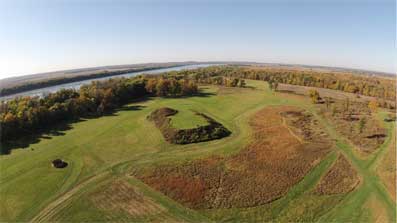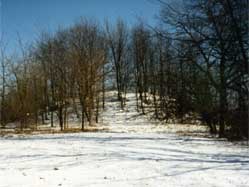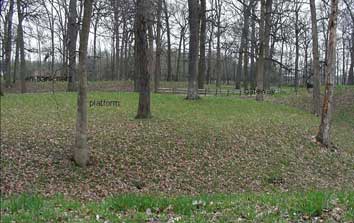Indiana's Mounds & Earthworks
Mounds and earthworks are man-made structures that include isolated mounds, enclosures of various shapes, and complexes of multiple mounds and earthworks. While archaeologists consider them precontact sites, many Native American cultures recognize them as sacred places. Beginning in 2008, an inventory of Indiana’s mounds and earthworks was begun by collecting information from written sources such as county histories, geological surveys, and archaeology reports for information relating to mounds and other earthworks. Written accounts of Indiana’s earthworks began accumulating as early as the 1790s. No fieldwork, survey, or other investigation was performed. The project created a comprehensive database of site locations, descriptions and recommendations for future treatments.
Documentation for 1,183 sites that contain at least 2,100 individual earthworks was collected. The records shows that mounds and earthworks are found in almost every county. Several patterns were recognized as a result of the project.
- Almost all the earthworks in the state were reported to archaeologists and were not discovered through systematic archaeological investigations.
- Site locations are, in general, poorly recorded and most of the sites need additional investigations to record more precise locations and to document their current conditions since many of them have not been surveyed by an archaeologist in several decades.
- Virtually all of Indiana’s earthworks have been damaged by uncontrolled digging and various agricultural and construction activities.
- Many of the reported mounds that have been visited by an archaeologist were determined to be natural features (not man-made) created by glacial activity and erosion. Natural features can still be archaeological sites that were used for occupation or burials.
- Overall, the earthworks within the state are very poorly documented.
DHPA continues to maintain and update the inventory of Indiana’s mounds and earthworks. Future goals include:
- Continued education/training. Mounds and earthworks are a specific type of site and require a certain level of understanding and training to identify and assess. Providing continued education and training to professionals, avocationals, and the general public will help protect the mounds and earthworks that remain.
- Field verification of mounds and earthworks. Many of the sites identified through this project have vague location information, have not been visited by professional archaeologists, or are in rapidly developing areas. It is important for qualified archaeologists to assess and document sites that are endangered or about which little is known. Recording standardized information will help better document and assess mounds and earthworks.
- Listing mounds and earthworks in the National Register of Historic Places. As field verification and investigation is undertaken, sites should be evaluated for eligibility to the National Register.
What can you do?
- Report looting or damage to a mound or earthwork.
- Become an advocate for the preservation of archaeological sites:
- Understand the laws that protect archaeology sites in Indiana;
- Encourage others to learn about mounds and earthworks;
- Support efforts to have more mounds and earthworks listed in the National Register of Historic Places;
- Participate in Indiana Archaeology Month activities;
- Donate to archaeology efforts such as the Archeology Preservation Trust Fund and the Archaeological Conservancy;
- Encourage government, planning, and development agencies to respect archaeological sites;
- Advocate for more funding for archaeological projects.
- Visit mound sites that are open to the public and learn more about these important places
The inventory was the result of DHPA working with several key archaeology partners from the University of Notre Dame, Indiana University-Purdue University at Fort Wayne, Ball State University and Gray & Pape, Inc., to obtain a Preserve America grant from the National Park Service to create the inventory Native American mounds earthworks throughout Indiana.



